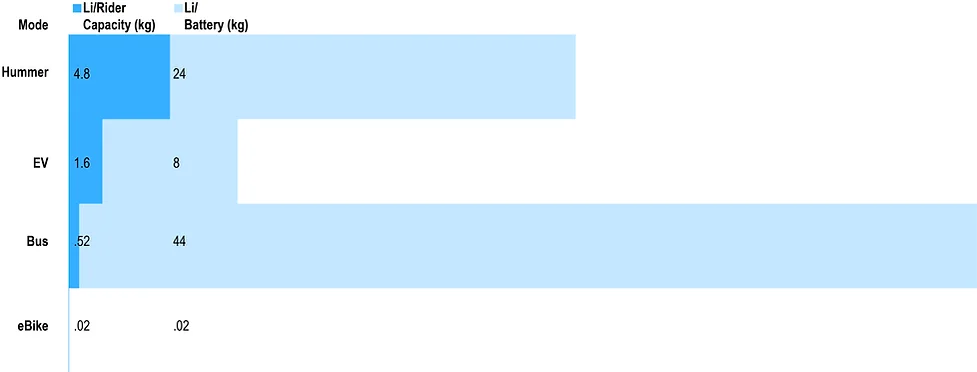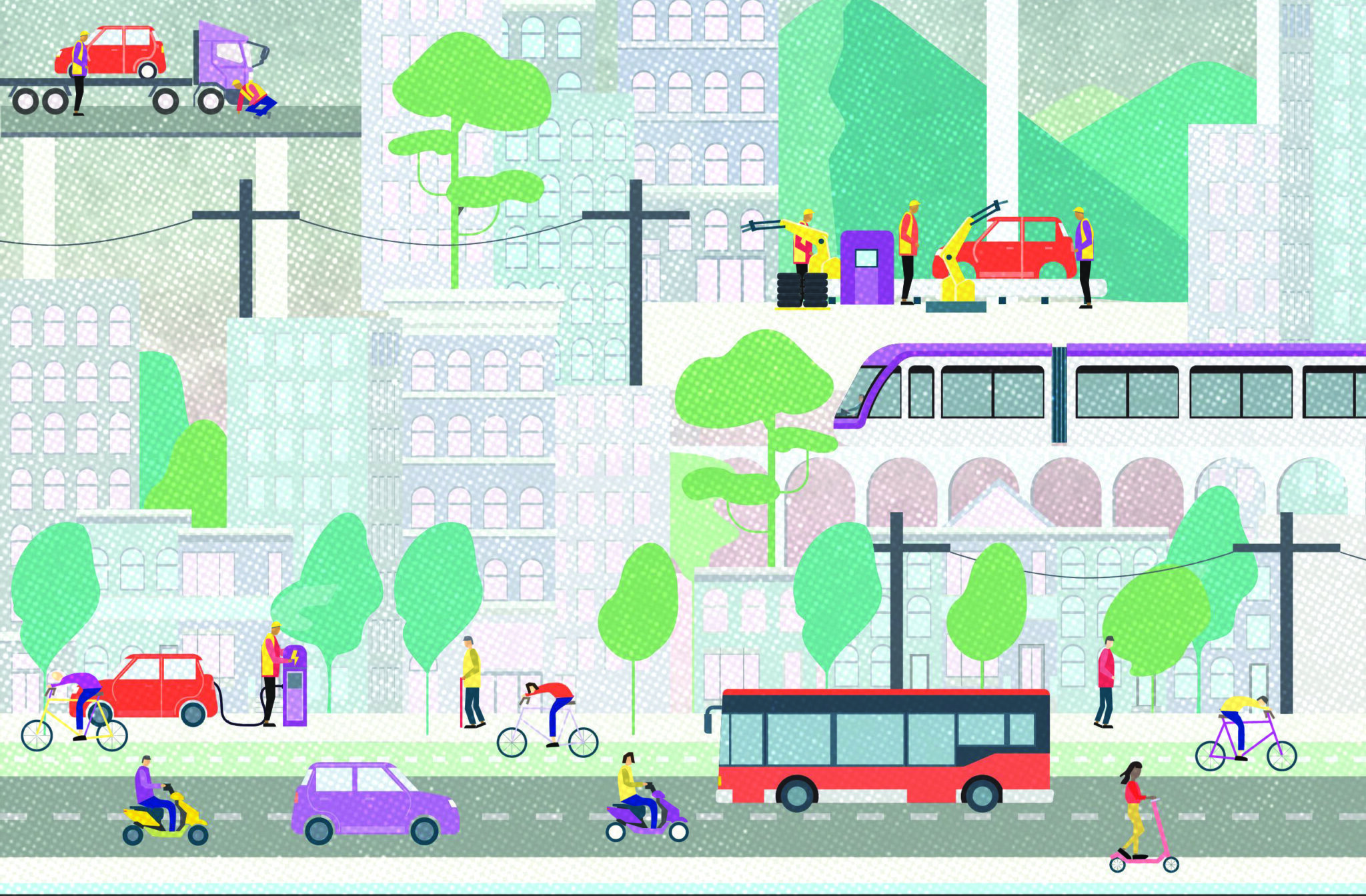Achieving Zero Emissions with More Mobility and Less Mining
Transportation is the number one source of carbon emissions in the United States– making the sector crucial to decarbonize quickly to limit the climate crisis. States like New York and California banned the sale of gas cars by 2035 and the 2022 Inflation Reduction Act made major federal investments in electrifying transportation. As a result, US consumers are embracing electric vehicles (EVs), with over half of the nation’s car sales predicted to be electric by 2030. This is a critical juncture. Decisions made now will affect the speed of decarbonization and the mobility of millions. Zero emissions transportation will also see the transformation of global supply chains, with implications for climate, environmental, and Indigenous justice beyond US borders.
A crucial aspect of electrified transportation is new demand for metals, and specifically the most non-replaceable metal for EV batteries–lithium. If today’s demand for EVs is projected to 2050, the lithium requirements of the US EV market alone in 2050 would require triple the amount of lithium currently produced for the entire global market. This boom in demand would be met by the expansion of mining.
Large-scale mining entails social and environmental harm, in many cases irreversibly damaging landscapes without the consent of affected communities. As societies undertake the urgent and transformative task of building new, zero-emissions energy systems, some level of mining is necessary. But the volume of extraction is not a given. Neither is where mining takes place, who bears the social and environmental burdens, or how mining is governed.
This report finds that the United States can achieve zero emissions transportation while limiting the amount of lithium mining necessary by reducing the car dependence of the transportation system, decreasing the size of electric vehicle batteries, and maximizing lithium recycling. Reordering the US transportation system through policy and spending shifts to prioritize public and active transit while reducing car dependency can also ensure transit equity, protect ecosystems, respect Indigenous rights, and meet the demands of global justice.
We designed a novel material flow analysis paired with socioeconomic pathway modeling to determine possible scenarios for the decarbonization of personal transportation in the US. The transportation sector is the only sector in which emissions are still steadily rising; within it, most emissions come from light-duty vehicles. We compare the lithium requirements of four pathways to zero-emissions personal transportation: an electrified continuation of the current US car-dependent status quo, and three scenarios that adopt increasingly ambitious policies to support public and active transportation and reduced car dependency.
Key Findings
- Lithium demand can be reduced by up to 92 percent in 2050 in comparison to the most lithium-intensive scenarios. This can be done by employing three key policy interventions: decreasing car dependency, right-sizing EV batteries, and creating a robust recycling system.
- The size of EV batteries have grown three fold since the first commercial EV. Even if the car-centricity of the US transportation system continues, limiting the size of EV batteries alone can cut lithium demand by as much as 42 percent.

Policies that increase and incentivize active and mass transit, lower the size of EVs and their batteries, and responsibly source their minerals will support a rapid and equitable transportation transition by reducing the battery demand of a zero-carbon transportation future. The benefits of this ambitious approach go beyond the transportation sector:
- Centering the Frontlines of Lithium Mining: Too often, transit justice, environmental justice, and Indigenous justice are pitted against each other in conversations about the decarbonization of the US transportation system. This report attempts to bring the many shared goals of these movements into conversation. We examine four cases of lithium mining: Argentina, Chile, the United States, and Portugal. In each of these cases, proposed or ongoing lithium mining has concerning implications for drought intensity, ecosystem biodiversity, and Indigenous sovereignty and/or community participation in projects that threaten cultural landscapes and economic livelihoods. Reducing the lithium intensity of electrified transportation would in turn mitigate a key driver of these harms.
- Reducing Geopolitical Tensions: With new demand for lithium and other energy transition related metals comes new mining, a global industry notorious for its environmental destruction and concerning record of human rights abuses and violence. In addition to these local harms, so-called “critical minerals” are a site of geopolitical tension. Lithium supply chains span the world from Latin America to China to Australia, with new extraction being planned in Europe, Canada, the United States and beyond. The massive uptick in demand is already producing supply bottlenecks for EV production, slowing EV uptake, calling into question their affordability, and stoking geopolitical tension as nations compete for access to lithium deposits. Lowering the amount of lithium necessary for decarbonization will limit bottlenecks and lower the potential of environmental degradation, injustice, and conflicts associated with mining.
- Achieving Climate Targets: Mining-related harms and looming supply constraints are two reasons to reduce the material intensity of electrified transportation. In addition, existing research has found expanding mass transit hastens decarbonization. A combination of vehicle electrification, declines in car usage and ownership, and reductions in the size and weight of personal vehicles (to increase their energy efficiency) are necessary steps that must be pursued in combination to remain within a sectoral carbon budget consistent with limiting to 1.5-2°C of warming. The speed of decarbonization of light-duty vehicles is limited by the turnover of the existing vehicle fleet and its replacement with EVs, as well as the decarbonization of the electricity grid. Producing EVs and building and maintaining roads, highways, and parking lots are energy- and emissions-intensive processes with high levels of embodied carbon. Electrification of the US transportation system will massively increase the demand for electricity while the transition to a decarbonized electricity grid is still underway, increasing the magnitude of that challenge. Public transit and active transit tend to be dramatically more energy-efficient methods of allowing people to move around; increasing the shares of travel happening by these modes will hasten decarbonization.
- Designing Safer Communities: Increasing mass and active transit as well as keeping passenger vehicles smaller make safer communities. Reducing the size of passenger vehicles also can make the roads far safer because smaller cars have fewer and less severe crashes. Making bus routes, metros, electric bikes faster, safer, and more convenient will disproportionately support low-income and non-white community members– who are more likely to live near high traffic areas and bear the environmental health burdens of relatively poorer air quality compared to higher income and white counterparts.
Major investments to shift away from US car dependency would have benefits from the frontlines of mining, which would see reduced social and environmental harms, to densified metropolitan areas throughout the country, which would experience myriad benefits from improved air quality to pedestrian safety. Ultimately, climate, transit and Indigenous justice can be aligned. Doing so requires an ambitious rethink of the energy transition that emphasizes benefits for communities and ecosystems most impacted by the climate crisis. In order to achieve a just future, the movement for climate justice must present a united front against profit-driven extraction.





